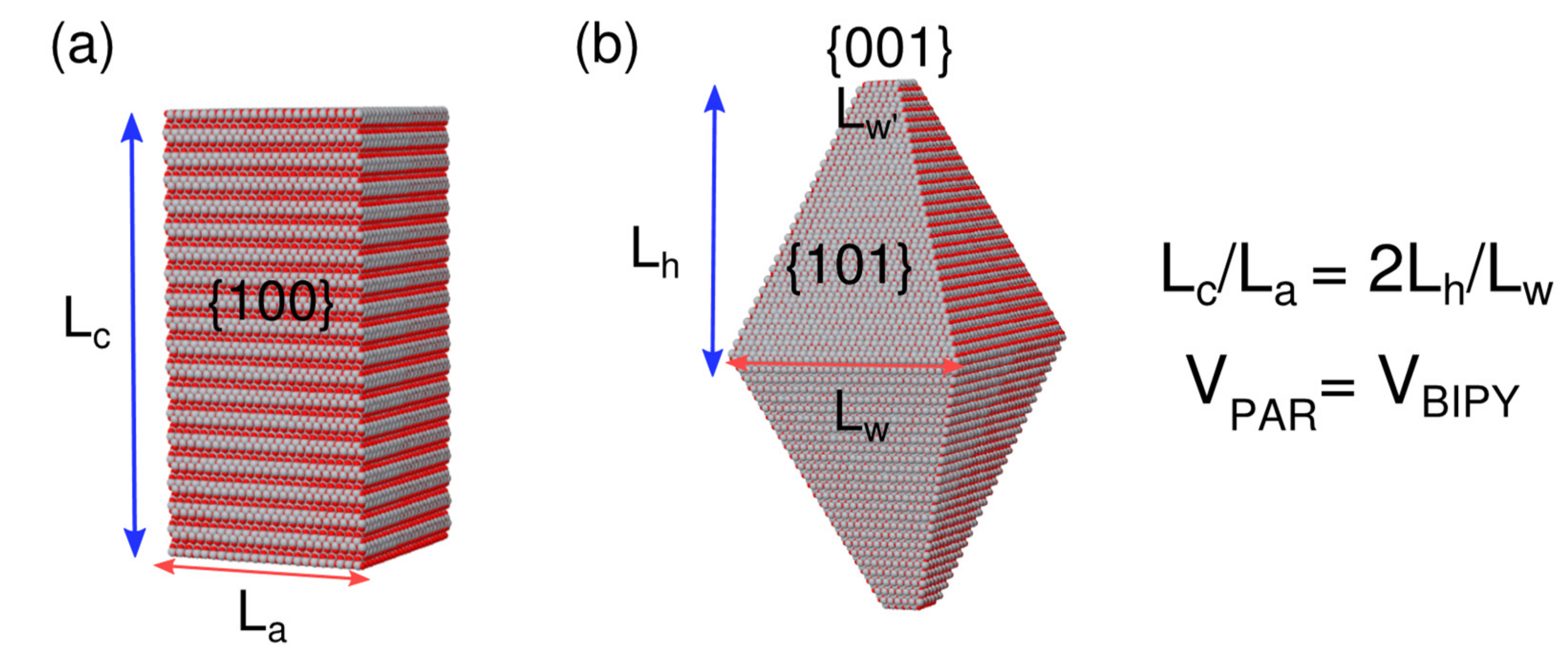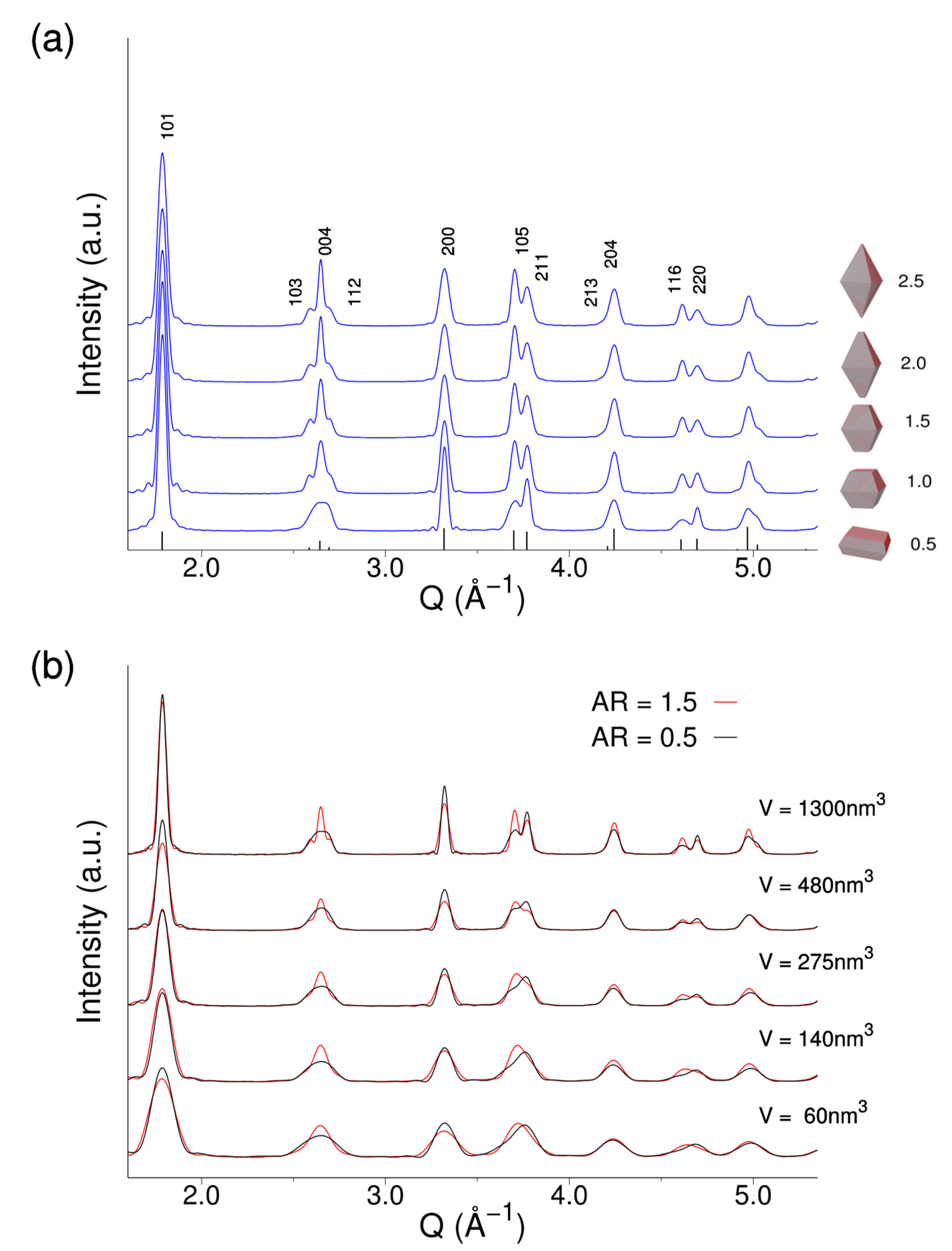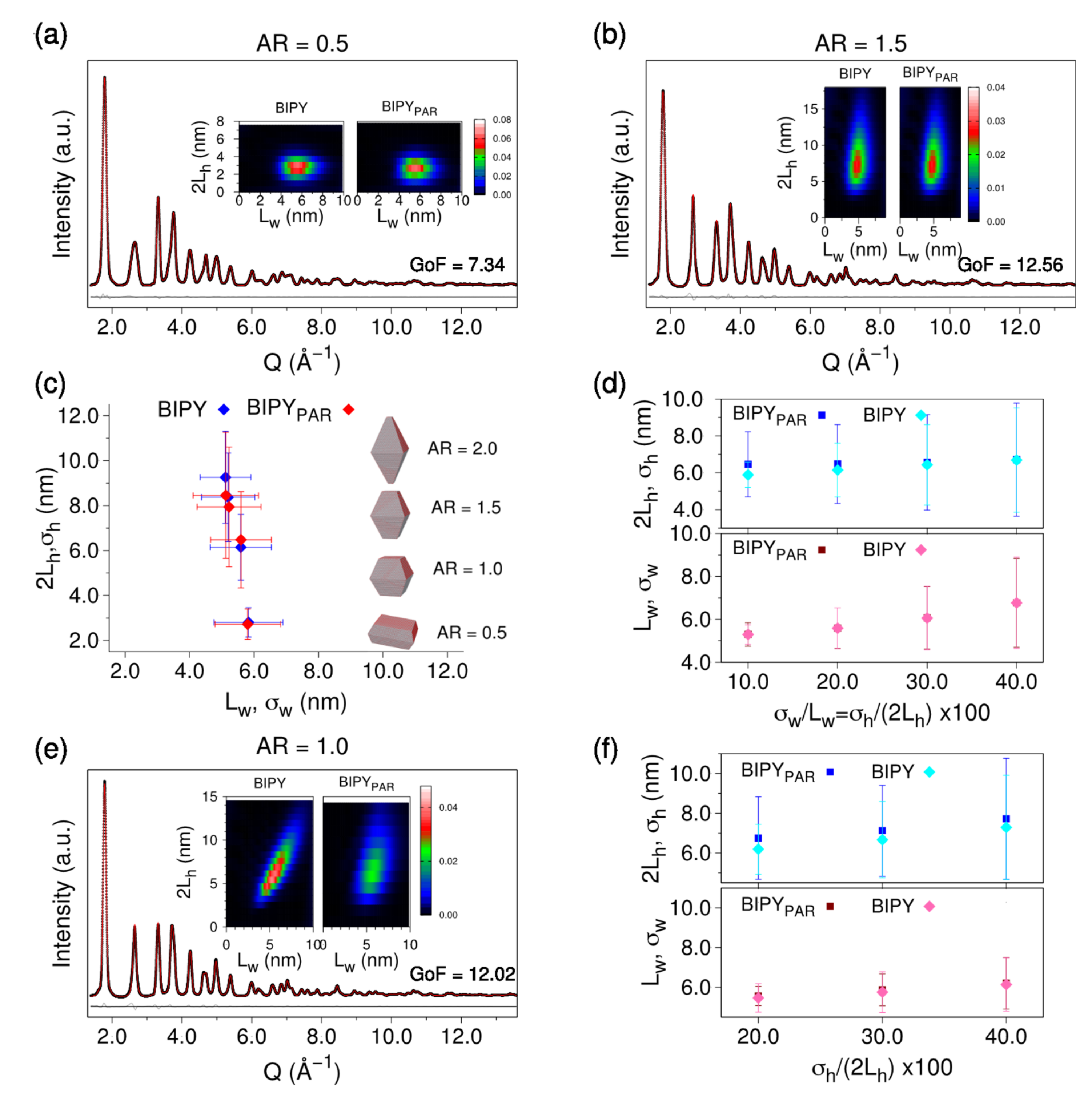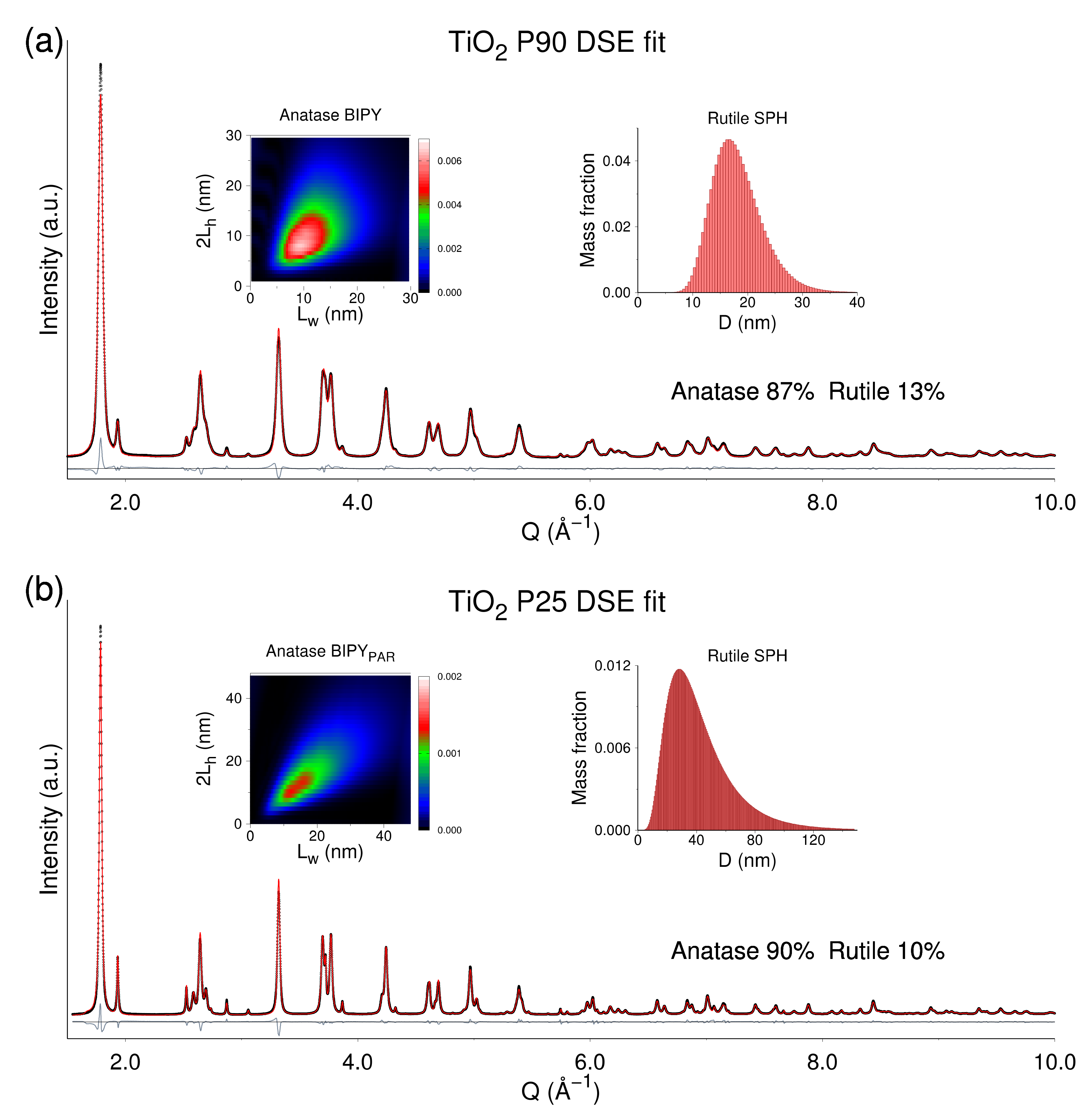Structure, Morphology, and Faceting of TiO2 Photocatalysts by the Debye Scattering Equation Method. The P25 and P90 Cases of Study
Abstract
1. Introduction
2. Materials and Methods
2.1. Synchrotron Wide-Angle X-Ray Scattering (WAXTS) Data Collection and Reduction
2.2. The Debye Scattering Equation Approach
2.3. Geometrical Mapping of Square Prisms and Truncated Square Bipyramids of D4h Symmetry
3. Results and Discussion
3.1. Influence of Nanocrystals (NCs) Morphology and Facets Surface Area on the WAXTS Pattern of Anatase
3.2. Analysis of P25 and P90 WAXTS Data by Conventional Rietveld Analysis
3.3. Analysis of P25 and P90 WAXTS Data through the Debye Scattering Equation (DSE)
4. Conclusions
Supplementary Materials
Author Contributions
Funding
Acknowledgments
Conflicts of Interest
Appendix A
| AR = 0.5 | AR = 1.0 | AR = 1.5 | AR = 2.0 | |
|---|---|---|---|---|
| BIPY–BIPYPAR | BIPY–BIPYPAR | BIPY–BIPYPAR | BIPY–BIPYPAR | |
| <Lw>M (nm) | 5.83–5.80 | 5.59–5.59 | 5.19–5.22 | 5.11–5.12 |
| <2Lh>M (nm) | 2.80–2.72 | 6.14–6.48 | 8.37–7.94 | 9.26–8.45 |
| σw/<Lw>M (×100) | 18.36–17.55 | 16.99–16.86 | 15.87–19.00 | 15.44–19.76 |
| σh/<2Lh>M (×100) | 23.37–24.96 | 23.75–33.06 | 23.55–33.51 | 22.15–33.16 |
| AR = <2Lh>M/<Lw>M | 0.48–0.47 | 1.10–1.16 | 1.61–1.52 | 1.81–1.65 |
| AR = <2Lh/Lw>M | 0.50–0.48 | 1.13–1.18 | 1.64–1.54 | 1.83–1.67 |
| {001} surface area % | 41.34–42.71 | 15.17–15.02 | 6.04–8.34 | 3.90–6.62 |
| {101} surface area % | 58.66–57.29 | 84.83–84.98 | 93.96–91.66 | 96.10–93.38 |
| P90 (BIPY) | P90 (BIPYPAR) | P25 (BIPYPAR) | ||||
|---|---|---|---|---|---|---|
| Anatase | Rutile | Anatase | Rutile | Anatase | Rutile | |
| <Lw>N, (nm) | 8.68 | - | 8.76 | - | 9.95 | - |
| <2Lh>N (nm) | 8.79 | - | 9.01 | - | 9.01 | - |
| σw/<Lw>N (×100) | 44.01 | - | 43.39 | - | 58.25 | - |
| σh/<2Lh>N (×100) | 54.76 | - | 53.33 | - | 62.42 | - |
| AR = <2Lh>N/<Lw>N | 1.01 | - | 1.03 | - | 0.91 | - |
| <D>N (nm) σ/<D>N (×100) | 9.06 41.67 | 15.21 24.61 | 9.14 40.87 | 15.68 22.54 | 11.72 55.61 | 18.90 55.50 |
References
- Zhang, H.; Banfield, J.F. Structural Characteristics and Mechanical and Thermodynamic Properties of Nanocrystalline TiO2. Chem. Rev. 2014, 114, 9613–9644. [Google Scholar] [CrossRef] [PubMed]
- Lazzeri, M.; Vittadini, A.; Selloni, A. Structure and energetics of stoichiometric TiO2 anatase surfaces. Phys. Rev. B 2001, 63, 155409. [Google Scholar] [CrossRef]
- Zhang, Z.; Wu, Q.; Johnson, G.; Ye, Y.; Li, X.; Li, N.; Cui, M.; Lee, J.D.; Liu, C.; Zhao, S.; et al. Generalized Synthetic Strategy for Transition-Metal-Doped Brookite-Phase TiO2 Nanorods. J. Am. Chem. Soc. 2019, 141, 16548–16552. [Google Scholar] [CrossRef] [PubMed]
- Deskins, N.A.; Kerisit, S.; Rosso, K.M.; Dupuis, M. Molecular Dynamics Characterization of Rutile-Anatase Interfaces. J. Phys. Chem. C 2007, 111, 9290–9298. [Google Scholar] [CrossRef]
- Liu, J.; Olds, D.; Peng, R.; Yu, L.; Foo, G.S.; Qian, S.; Keum, J.; Guiton, B.S.; Wu, Z.; Page, K. Quantitative Analysis of the Morphology of {101} and {001} Faceted Anatase TiO2 Nanocrystals and Its Implication on Photocatalytic Activity. Chem. Mater. 2017, 29, 5591–5604. [Google Scholar] [CrossRef]
- Liu, L.; Gu, X.; Ji, Z.; Zou, W.; Tang, C.; Gao, F.; Dong, L. Anion-assisted synthesis of TiO2 nanocrystals with tunable crystal forms and crystal facets and their photocatalytic redox activities in organic reactions. J. Phys. Chem. C 2013, 117, 18578–18587. [Google Scholar]
- Liu, G.; Yang, H.G.; Pan, J.; Yang, Y.Q.; Lu, G.Q.; Cheng, H.-M. Titanium dioxide crystals with tailored facets. Chem. Rev. 2014, 114, 9559–9612. [Google Scholar] [CrossRef]
- Pellegrino, F.; Sordello, F.; Mino, L.; Minero, C.; Hodoroaba, V.-D.; Martra, G.; Maurino, V. Formic acid photoreforming for hydrogen production on shape-controlled anatase TiO2 nanoparticles: assessment of the role of fluorides, {101}/{001} surfaces ratio, and platinization. ACS Catal. 2019, 9, 6692–6697. [Google Scholar] [CrossRef]
- Han, X.; Kuang, Q.; Jin, M.; Xie, Z.; Zheng, L. Synthesis of titania nanosheets with a high percentage of exposed (001) facets and related photocatalytic properties. J. Am. Chem. Soc. 2009, 131, 3152–3153. [Google Scholar] [CrossRef]
- Gong, X.-Q.; Selloni, A. Reactivity of anatase TiO2 nanoparticles: The role of the minority (001) surface. J. Phys. Chem. B 2005, 109, 19560–19562. [Google Scholar] [CrossRef]
- Pan, J.; Liu, G.; Lu, G.Q.; Cheng, H.-M. On the true photoreactivity order of 001, 010, and 101 facets of anatase TiO2 crystals. Angew. Chem. Int. Ed. 2011, 50, 2133–2137. [Google Scholar] [CrossRef] [PubMed]
- Maisano, M.; Dozzi, M.V.; Coduri, M.; Artiglia, L.; Granozzi, G.; Selli, E. Unraveling the multiple effects originating the increased oxidative photoactivity of {001}-facet enriched anatase TiO2. ACS Appl. Mater. Interfaces 2016, 8, 9745–9754. [Google Scholar] [CrossRef] [PubMed]
- Egami, T.; Billinge, S.J.L. Underneath the Bragg Peaks. Structural Analysis of Complex Materials; Cahn, R.W., Ed.; Pergamon Materials Series: Oxford, UK, 2003. [Google Scholar]
- Juhás, P.; Farrow, C.L.; Yang, X.; Knox, K.R.; Billinge, S.J.L. Complex modeling: a strategy and software program for combining multiple information sources to solve ill posed structure and nanostructure inverse problems. Acta Crystallogr. A 2015, 71, 562–568. [Google Scholar]
- Cervellino, A.; Frison, R.; Masciocchi, N.; Guagliardi, A. X-ray and Neutron Techniques for Nanomaterials Characterization; Kumar, C.S.S.R., Ed.; Springer: Berlin, Germany, 2016; pp. 545–608. [Google Scholar]
- Bertolotti, F.; Moscheni, D.; Guagliardi, A.; Masciocchi, N. When crystals go nano - The role of advanced X-ray total scattering methods in nanotechnology. Eur. J. Inorg. Chem. 2018, 34, 3789–3803. [Google Scholar]
- Cernuto, G.; Galli, S.; Trudu, F.; Colonna, G.M.; Masciocchi, N.; Cervellino, A.; Guagliardi, A. Investigating the amorphous-crystalline interplay in SiO2/TiO2 nanocomposites by total scattering methods. Angew. Chem. Int. Ed. 2011, 50, 10828–10833. [Google Scholar]
- Cernuto, G.; Masciocchi, N.; Cervellino, A.; Colonna, G.M.; Guagliardi, A. Size and shape dependence of the photocatalytic activity of TiO2 nanocrystals: a total scattering Debye function study. J. Am. Chem. Soc 2011, 133, 3114–3119. [Google Scholar] [CrossRef]
- Frison, R.; Cernuto, G.; Cervellino, A.; Zaharko, O.; Colonna, G.M.; Guagliardi, A.; Masciocchi, N. Magnetite–maghemite nanoparticles in the 5–15 nm range: Correlating the core–shell composition and the surface structure to the magnetic properties. A total scattering study. Chem. Mater. 2013, 25, 4820–4827. [Google Scholar] [CrossRef]
- Delgado-López, J.M.; Frison, R.; Cervellino, A.; Gómez-Morales, J.; Guagliardi, A.; Masciocchi, N. Crystal size, morphology, and growth mechanism in bio-inspired apatite nanocrystals. Adv. Funct. Mater. 2014, 24, 1090–1099. [Google Scholar] [CrossRef]
- Bertolotti, F.; Maspero, A.; Cervellino, A.; Guagliardi, A.; Masciocchi, N. Bending by faulting: A multiple scale study of copper and silver nitropyrazolates. Cryst. Growth Des. 2014, 14, 2913–2922. [Google Scholar] [CrossRef]
- Bertolotti, F.; Dirin, D.N.; Ibanez, M.; Krumeich, F.; Cervellino, A.; Frison, R.; Voznyy, O.; Sargent, E.H.; Kovalenko, M.V.; Guagliardi, A.; et al. Crystal symmetry breaking and vacancies in colloidal lead chalcogenide quantum dots. Nat. Mater. 2016, 15, 987–994. [Google Scholar]
- Bertolotti, F.; Moscheni, D.; Migliori, A.; Zacchini, S.; Cervellino, A.; Guagliardi, A.; Masciocchi, N. A total scattering Debye function analysis study of faulted Pt nanocrystals embedded in a porous matrix. Acta Crystallogr. A 2016, 72, 632–644. [Google Scholar] [CrossRef]
- Bertolotti, F.; Protesescu, L.; Kovalenko, M.V.; Yakunin, S.; Cervellino, A.; Billinge, S.J.L.; Terban, M.W.; Pedersen, J.S.; Masciocchi, N.; Guagliardi, A. Coherent nanotwins and dynamic disorder in cesium lead halide perovskite nanocrystals. ACS Nano 2017, 11, 3819–3831. [Google Scholar] [CrossRef] [PubMed]
- Moscheni, D.; Bertolotti, F.; Piveteau, L.; Protesescu, L.; Dirin, D.N.; Kovalenko, M.V.; Cervellino, A.; Pedersen, J.S.; Masciocchi, N.; Guagliardi, A. Size-dependent fault-driven relaxation and faceting in zincblende CdSe colloidal quantum dots. ACS Nano 2018, 12, 12558–12570. [Google Scholar] [CrossRef] [PubMed]
- Bertolotti, F.; Nedelcu, G.; Vivani, A.; Cervellino, A.; Masciocchi, N.; Guagliardi, A.; Kovalenko, M.V. Crystal structure, morphology, and surface termination of cyan-emissive, six-monolayers-thick CsPbBr3 nanoplatelets from X-ray total scattering. ACS Nano 2019, 13, 14294–14307. [Google Scholar] [CrossRef] [PubMed]
- Datye, A.K.; Riegel, G.; Bolton, J.R.; Huang, M.; Prairie, M.R. Microstructural characterization of a fumed titanium dioxide photocatalyst. J. Solid State Chem. 1995, 115, 236–239. [Google Scholar] [CrossRef]
- Ohno, T.; Sarukawa, K.; Tokieda, K.; Matsumura, M. Morphology of a TiO2 photocatalyst (Degussa, P-25) consisting of anatase and rutile crystalline phases. J. Catal. 2001, 203, 82–86. [Google Scholar] [CrossRef]
- Bakardjieva, S.; Šubrt, J.; Štengl, V.; Dianez, M.J.; Sayagues, M.J. Photoactivity of anatase–rutile TiO2 nanocrystalline mixtures obtained by heat treatment of homogeneously precipitated anatase. Applied Catal. B-Environ. 2005, 58, 193–202. [Google Scholar]
- Schmidt, C.M.; Weitz, E.; Geiger, F.M. Interaction of the indoor air pollutant acetone with Degussa P25 TiO2 studied by chemical ionization mass spectrometry. Langmuir 2006, 22, 9642–9650. [Google Scholar] [CrossRef]
- Ohtani, B.; Prieto-Mahaney, O.O.; Li, D.; Abe, R. What is Degussa (Evonik) P25? Crystalline composition analysis, reconstruction from isolated pure particles and photocatalytic activity test. J. Photoch. Photobio. A 2010, 216, 179–182. [Google Scholar] [CrossRef]
- Minella, M.; Faga, M.G.; Maurino, V.; Minero, C.; Pelizzetti, E.; Coluccia, S.; Martra, G. Effect of Fluorination on the Surface Properties of Titania P25 Powder: An FTIR Study. Langmuir 2010, 26, 2521–2527. [Google Scholar]
- Zhang, H.; Lv, X.; Li, Y.; Wang, Y.; Li, J. P25-graphene composite as a high performance photocatalyst. ACS Nano 2010, 4, 380–386. [Google Scholar] [CrossRef] [PubMed]
- Deiana, C.; Minella, M.; Tabacchi, G.; Maurino, V.; Fois, E.; Martra, G. Shape-controlled TiO2 nanoparticles and TiO2 P25 interacting with CO and H2O2 molecular probes: a synergic approach for surface structure recognition and physico-chemical understanding. Phys. Chem. Chem. Phys. 2013, 15, 307–315. [Google Scholar] [CrossRef] [PubMed]
- Shiraishi, Y.; Sakamoto, H.; Fujiwara, K.; Ichikawa, S.; Hirai, T. Selective photocatalytic oxidation of aniline to nitrosobenzene by pt nanoparticles supported on TiO2 under visible light irradiation. ACS Catal. 2014, 4, 2418–2425. [Google Scholar] [CrossRef]
- Wei, W.; Liu, D.; Wei, Z.; Zhu, Y. Short-range π–π stacking assembly on P25 TiO2 nanoparticles for enhanced visible-light photocatalysis. ACS Catal. 2017, 7, 652–663. [Google Scholar] [CrossRef]
- Su, R.; Bechstein, R.; Sø, L.; Vang, R.T.; Sillassen, M.; Esbjörnsson, B.; Palmqvist, A.; Besenbacher, F. How the anatase-to-rutile ratio influences the photoreactivity of TiO2. J. Phys. Chem. C 2011, 115, 24287–24292. [Google Scholar] [CrossRef]
- Holm, A.; Hamandi, M.; Simonet, F.; Jouguet, B.; Dappozze, F.; Guillard, C. Impact of rutile and anatase phase on the photocatalytic decomposition of lactic acid. Appl.Catal. B-Environ. 2019, 253, 96–104. [Google Scholar] [CrossRef]
- Banerjee, S.; Zangiabadi, A.; Mahdavi-Shakib, A.; Husremovic, S.; Frederick, B.G.; Barmak, K.; Austin, R.N.; Billinge, S.J.L. Quantitative structural characterization of catalytically active TiO2 nanoparticles. ACS Appl. Nano Mater. 2019, 2, 6268–6276. [Google Scholar] [CrossRef]
- Willmott, P.R.; Meister, D.; Leake, S.J.; Lange, M.; Bergamaschi, A.; Boge, M.; Calvi, M.; Cancellieri, C.; Casati, N.; Cervellino, A.; et al. The materials science beamline upgrade at the Swiss Light Source. J. Synchrotron Rad. 2013, 20, 667–682. [Google Scholar] [CrossRef]
- Bergamaschi, A.; Cervellino, A.; Dinapoli, R.; Gozzo, F.; Henrich, B.; Johnson, I.; Kraft, P.; Mozzanica, A.; Schmitt, B.; Shi, X. The MYTHEN detector for X-ray powder diffraction experiments at the Swiss Light Source. J. Synchrotron Radiat. 2010, 17, 653–668. [Google Scholar] [CrossRef]
- Paalman, H.H.; Pings, C.J. Numerical evaluation of X--Ray absorption factors for cylindrical samples and annular sample cells. J. Appl. Phys. 1962, 33, 2635–2639. [Google Scholar] [CrossRef]
- Bowden, M.; Ryan, M. Absorption correction for cylindrical and annular specimens and their containers or supports. J. Appl. Cryst. 2010, 43, 693–698. [Google Scholar] [CrossRef]
- Debye, P. Zerstreuung von Röntgenstrahlen. Ann. Phys. 1915, 351, 809–823. [Google Scholar] [CrossRef]
- Cervellino, A.; Frison, R.; Bertolotti, F.; Guagliardi, A. DEBUSSY 2.0: the new release of a Debye user system for nanocrystalline and/or disordered materials. J. Appl. Cryst. 2015, 48, 2026–2032. [Google Scholar] [CrossRef]
- Topas-R, V3.0; Bruker AXS: Karlsruhe, Germany, 2005.
- Cervellino, A.; Giannini, C.; Guagliardi, A. On the efficient evaluation of Fourier patterns for nanoparticles and clusters. J. Comput. Chem. 2006, 27, 995–1008. [Google Scholar] [CrossRef]
- Nelder, J.A.; Mead, R. A Simplex Method for Function Minimization. Comput. J. 1965, 7, 308–313. [Google Scholar] [CrossRef]
- Jeantelot, G.; Ould-Chikh, S.; Sofack-Kreutzer, J.; Abou-Hamad, E.; Anjum, D.H.; Lopatin, S.; Harb, M.; Cavallo, L.; Basset, J.-M. Morphology control of anatase TiO2 for well-defined surface chemistry. Phys. Chem. Chem. Phys. 2018, 20, 14362–14373. [Google Scholar] [CrossRef]
- Horn, M.; Schwebdtfeger, C.F.; Meagher, E.P. Refinement of the structure of anatase at several temperatures. Z. Kristallogr. - Cryst. Mater. 2015, 136, 273–281. [Google Scholar] [CrossRef]
- Swope, R.J.; Smyth, J.R.; Larson, A.C. H in rutile-type compounds: I. Single-crystal neutron and X-ray diffraction study of H in rutile. Am. Mineral. 2015, 80, 448–453. [Google Scholar] [CrossRef]
- Ulbrich, K.F.; Bertolotti, F.; Masciocchi, N.; Cervellino, A.; Guagliardi, A.; Campos, C.E.M. A comprehensive structural and microstructural investigation of a new iron–telluride nano phase. J. Mater. Chem. C 2018, 6, 3047–3057. [Google Scholar] [CrossRef]
- Hurum, D.C.; Agrios, A.G.; Gray, K.A.; Rajh, T.; Thurnauer, M.C. Explaining the enhanced photocatalytic activity of Degussa P25 mixed-phase TiO2 using EPR. J. Phys. Chem. B 2003, 107, 4545–4549. [Google Scholar] [CrossRef]
- Carbajo, J.; Tolosana-Moranchel, A.; Casas, J.A.; Faraldos, M.; Bahamonde, A. Analysis of photoefficiency in TiO2 aqueous suspensions: Effect of titania hydrodynamic particle size and catalyst loading on their optical properties. Appl. Catal. B-Environ. 2018, 221, 1–8. [Google Scholar] [CrossRef]
- Carbajo, J.; García-Muñoz, P.; Tolosana-Moranchel, A.; Faraldos, M.; Bahamonde, A. Effect of water composition on the photocatalytic removal of pesticides with different TiO2 catalysts. Environ. Sci. Pollut. Res. 2014, 21, 12233–12240. [Google Scholar] [CrossRef] [PubMed]
- Mozia, S.; Heciak, A.; Morawski, A.W. The influence of physico-chemical properties of TiO2 on photocatalytic generation of C1–C3 hydrocarbons and hydrogen from aqueous solution of acetic acid. Appl. Catal. B-Environ. 2011, 104, 21–29. [Google Scholar] [CrossRef]
- Zhao, C.; Liu, L.; Zhang, Q.; Rogers, J.; Zhao, H.; Li, Y. Synthesis of carbon-TiO2 nanocomposites with enhanced reversible capacity and cyclic performance as anodes for lithium-ion batteries. Electrochim. Acta 2015, 155, 288–296. [Google Scholar] [CrossRef]
- Carabin, A.; Drogui, P.; Robert, D. Photo-degradation of carbamazepine using TiO2 suspended photocatalysts. J. Taiwan Inst. Chem. E 2015, 54, 109–117. [Google Scholar] [CrossRef]
- Hernández Rodríguez, M.J.; Pulido Melián, E.; González Díaz, O.; Araña, J.; Macías, M.; González Orive, A.; Doña Rodríguez, J.M. Comparison of supported TiO2 catalysts in the photocatalytic degradation of NOx. J. Mol. Catal. A-Chem. 2016, 413, 56–66. [Google Scholar] [CrossRef]
- AEROXIDE, AERODISP and AEROPERL Titanium Dioxide as Photocatalyst - Technical information 1243. Evonik Industries. Available online: http://www.aerosil.com/sites/lists/RE/DocumentsSI/TI-1243-Titanium-Dioxide-as-Photocatalyst-EN.pdf (accessed on 10 April 2020).
- In, S. Comparison of photocatalytic performance of Degussa TiO2 P25 and P90 in gas phase photocatalytic reactor. Asian J. Chem. 2011, 23, 2629–2631. [Google Scholar]
- Bacsa, R.R.; Kiwi, J. Effect of rutile phase on the photocatalytic properties of nanocrystalline titania during the degradation of p-coumaric acid. Appl. Catal. B-Environ. 1998, 16, 19–29. [Google Scholar] [CrossRef]
- Kawahara, T.; Konishi, Y.; Tada, H.; Tohge, N.; Nishii, J.; Ito, S. A patterned TiO2(anatase)/TiO2(rutile) bilayer-type photocatalyst: Effect of the anatase/rutile junction on the photocatalytic activity. Angew. Chem. Int. Ed. 2002, 41, 2811–2813. [Google Scholar] [CrossRef]




| Parameter | P90 | P25 | ||
|---|---|---|---|---|
| Anatase | Rutile | Anatase | Rutile | |
| a, c (Å) | 3.7863, 9.4985 | 4.5947, 2.9592 | 3.7860, 9.5080 | 4.5947, 2.9592 |
| <CS>M (Iso, Aniso) (nm) | 15.6, 15.0 | 23.0, 23.0 | 26.8, 26.2 | 45.0, 45.3 |
| <CS>N (Nominal) (nm) | 14 | 21 | ||
| AR | 0.85 | - | 0.80 | - |
| wt (Iso, Aniso) % | 91.8, 91.8 | 8.2, 8.2 | 88.3, 88.4 | 11.7, 11.6 |
| RBragg (Iso, Aniso) | 2.4, 1.8 | 2.7, 2.5 | 2.1, 1.6 | 3.5, 3.1 |
| Rwp (Iso, Aniso) | 5.2, 4.5 | 5.8, 4.8 | ||
| Parameter | P90 (BIPY) | P90 (BIPYPAR) | P25 (BIPYPAR) | |||
|---|---|---|---|---|---|---|
| Anatase1 | Rutile | Anatase | Rutile | Anatase | Rutile | |
| <Lw >M, (nm) | 13.75 | - | 13.73 | - | 23.00 | - |
| <2Lh>M (nm) | 13.09 | - | 13.18 | - | 20.71 | - |
| σw/<Lw>M (×100) | 37.75 | - | 37.75 | - | 41.32 | - |
| σh/<2Lh>M (×100) | 50.06 | - | 51.25 | - | 50.98 | - |
| φ (°) | 41.00 | - | 42.54 | - | 42.80 | - |
| AR = <2Lh>M/<Lw> M | 0.95 | - | 0.95 | - | 0.89 | - |
| {001}, {101} surface % | 21.3, 78.8 | - | 20.86, 79.14 | - | 22.73, 77.37 | - |
| SSA (m2/g) | 147.4 | 146.6 | 95.6 | |||
| <D>M, (nm) σ/<D>M (×100) | 14.22, 36.07 | 18.13, 24.47 | 14.17, 36.08 | 18.19, 22.44 | 23.74, 9.68 | 41.85, 52.62 |
| wt% | 87.00 | 13.00 | 86.83 | 13.17 | 89.59 | 10.41 |
| B (Å2), Ti, O | 0.31, 0.89 | 0.44, 0.80 | 0.30, 0.84 | 0.44, 1.00 | 0.37, 0.99 | |
| S.o.f., Ti 2 | 0.94 | - | 0.95 | - | 0.92 | - |
| GoF | 11.57 | 12.12 | 11.05 | |||
© 2020 by the authors. Licensee MDPI, Basel, Switzerland. This article is an open access article distributed under the terms and conditions of the Creative Commons Attribution (CC BY) license (http://creativecommons.org/licenses/by/4.0/).
Share and Cite
Bertolotti, F.; Vivani, A.; Moscheni, D.; Ferri, F.; Cervellino, A.; Masciocchi, N.; Guagliardi, A. Structure, Morphology, and Faceting of TiO2 Photocatalysts by the Debye Scattering Equation Method. The P25 and P90 Cases of Study. Nanomaterials 2020, 10, 743. https://doi.org/10.3390/nano10040743
Bertolotti F, Vivani A, Moscheni D, Ferri F, Cervellino A, Masciocchi N, Guagliardi A. Structure, Morphology, and Faceting of TiO2 Photocatalysts by the Debye Scattering Equation Method. The P25 and P90 Cases of Study. Nanomaterials. 2020; 10(4):743. https://doi.org/10.3390/nano10040743
Chicago/Turabian StyleBertolotti, Federica, Anna Vivani, Daniele Moscheni, Fabio Ferri, Antonio Cervellino, Norberto Masciocchi, and Antonietta Guagliardi. 2020. "Structure, Morphology, and Faceting of TiO2 Photocatalysts by the Debye Scattering Equation Method. The P25 and P90 Cases of Study" Nanomaterials 10, no. 4: 743. https://doi.org/10.3390/nano10040743
APA StyleBertolotti, F., Vivani, A., Moscheni, D., Ferri, F., Cervellino, A., Masciocchi, N., & Guagliardi, A. (2020). Structure, Morphology, and Faceting of TiO2 Photocatalysts by the Debye Scattering Equation Method. The P25 and P90 Cases of Study. Nanomaterials, 10(4), 743. https://doi.org/10.3390/nano10040743





